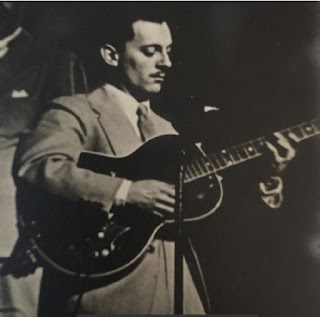 |
| Georg Lankester |
Etienne “Sarane”Ferret (1912 – 1970)
The second son of the Ferret family became the one who made far more jazz recordings than both his brothers, in total over 50 tracks. This is rather astonishing since he was hardly considered an established guitarist.
 |
| Etienne 'Sarane' Ferret |
Jazz
attracted Sarane right from the
start and, once in Paris, he rather soon played with violinist Michel Warlop as well as with the
accordionists Gus Viseur and Tony Murena, all great improvisers.
However,
of even more importance is that, in the early Forties, Sarane formed the Swing Quintette de Paris which gave us
many of his own compositions. More or less like Django’s new quintet, Sarane’s
formation included two clarinet players viz. André Lluis and Sylvio
Siobud. In the first recordings of
this quintet (1941) Matelo is
present in the rhythm group; shortly afterwards also Baro joined the quintet.
 |
| Odeon 281.494_Tiger Rag |
Somewhat
later Sarane replaced the two clarinettists by the violinist Robert Bermosa. A remarkable recording of this formation is
Sarane’s performance of the Tiger Rag with very quick runs in
his solos (like Django did in the Thirties). Also the violin player shows a
great ‘drive’ on this record.
 |
| Georges Effroses |
One year
later this ensemble is back in the studio but now with violinist Georges Effroses. Also Sarane’s
brothers are present in the rhythm group. Recordings show us a solo guitarist
with sometimes a lyrical way of improvising. The same can be said of the
Israelian violin player, who – in 1943 disappeared. Later it was revealed that
the artist had died in a concentration camp.
Towards the
end of the war a few records of Sarane and a string quartet were issued and the
formation now included guitarist Jacques
Montagne (member of the Malha family).Then follows a rather long gap, but
in the spring of 1947 Sarane finally made recordings again with his own group
now called Le Quintette de Paris featuring accordionist Gus Viseur. And again several years
passed.
 |
| Sarane Ferret in 1950s |
It was only
in the late Fifties that a number of tracks of Sarane and his orchestra came
out again; the band inluded several musicians who played with Django shortly
before his death in 1953.Some names: Benny
Vasseur, Roger Guérin and Maurice
Vander. For me personally, the recordings are not so interesting.
Sarane
Ferret finally died in 1970 (58 years old) as the first of the three brothers.
Georg Lankester
---
Jo
keepitswinging.domain@gmail.com
 Retrospect
Keep Swinging (old)
Oscar Aleman Choro Music Flexible Records Hit of the Week-Durium Friends of the Keep Swinging blog Keep Swinging Contributions
Retrospect
Keep Swinging (old)
Oscar Aleman Choro Music Flexible Records Hit of the Week-Durium Friends of the Keep Swinging blog Keep Swinging Contributions













